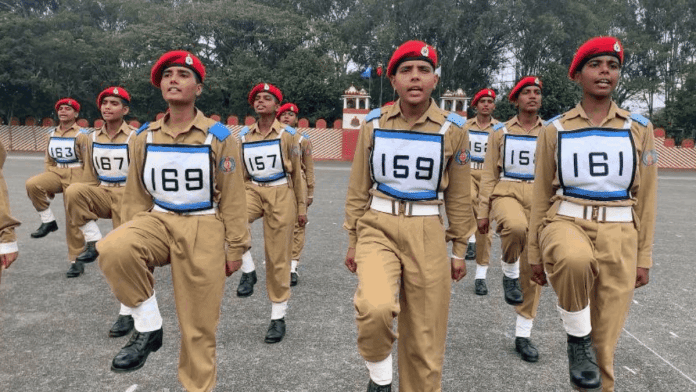Thank you dear subscribers, we are overwhelmed with your response.
Your Turn is a unique section from ThePrint featuring points of view from its subscribers. If you are a subscriber, have a point of view, please send it to us. If not, do subscribe here: https://theprint.in/subscribe/
Feminist epistemology values eliminating incongruities, yet women's inclusion in defence is often viewed as eccentric. India broke stereotypes with an all-female tri-service contingent at the Republic Day parade, highlighting empowerment potential. However, the enthusiasm quickly shifted.
Priyanka Tyagi, renowned for her valour in the Indian Coast Guard Service (ICG), saved 300 lives and amassed 4500 flight hours since 2016 with an all-female crew on a Dornier aircraft. Despite her exceptional service, her discharge as Commandant (JG) on December 30, 2023, sparked debate on gender equality operationalization. An affidavit on March 6, outlining "functional and operational" disabilities, was swiftly rejected by the Supreme Court, denouncing workplace discrimination. The allocation of just 10% of Permanent Commission (PC) slots for women in the ICG was challenged by the court, advocating for "Nari Shakti" (Women's power).
The sluggish growth of gender equality
In India, the question of women in front has been deemed an extrinsic success but with intrinsic fragmentation. Admiral Hari Kumar Singh articulated that India’s maritime strategy is shifting from affirmations of sea blindness to a more potent notion of “ aspiring maritime power”. Nonetheless, the question remains whether there is enough space for gender-neutral behaviour.
Initially recruited to the ICG on an experimental basis, women served in non-combat roles under the short-service Commission (SSC) for up to 3 years. Later, a 2005 notification extended the SSC duration for the women's special entry scheme (WSME) by up to 14 years, allowing substantive promotions. However, induction into combat roles remained limited and also posed challenges for SSC officers transitioning to civilian life without the security of permanent employment compared to PCs which call for superannuation, arrears and promotions. The government stated in a 2009 petition that female officers in the Assistant Commandant Women Short Service Commission can't switch to permanent entry.
Nonetheless in 2017, the Coast Guard deployed women in combat roles on hovercrafts near India's coastal zones. Despite this, obstacles persist for women seeking PCs, with the government questioning "call beyond duty," citing concerns over subpar combat skills and familial duties. Efforts towards gender equality include gender-neutral language and attire, yet statistically only 10% of the Coast Guard totaling 130 officers, are women.
India ratified the Maritime Labour Convention 2006 on October 9, 2015, addressing the needs of women at sea with separate accommodation and medical care. An affidavit from ICG Deputy Inspector Raj Kamal Sinha revealed that appointment letters lacked provisions for women's PCs, citing that only 10% out of the 66% billets are for women thereby allocations favouring men for seaborne units. This highlights a gendered imbalance hindering security efficacy in services.
The gloomy reality in other areas
The Supreme Court of India upheld Articles 14 and 16, ensuring equality in public employment, and dismantling obstacles to women's right to excel, challenging marginalization in PC services.
In Babita Puniya vs. The Union of India, a PIL challenged Article 33 limiting armed forces officers' rights, leading to the overturning of Sections 10 and 12 of the Indian Army Act, nullifying laws barring women's entry. Kush Kalra vs. The Union of India revealed the paradox of Article 15(3), allowing "positive discrimination" yet withholding stable job opportunities. The Supreme Court's use of Article 142 challenged women's exclusion from military service, promoting capabilities over systemic disparities, resulting in the government allowing PCs for women in all 10 army branches.
On 5th September 2021, the Supreme Court allowed women “Agniveers” to appear for the National Defence Academy (NDA) entrance exam to serve in various combat roles and positions. Irrespective of this move, women are not able to qualify for the qualitative requirements.
women in the army must serve two years in operational command to be promoted, yet they are excluded from specialized combat roles like infantry and armoured corps. This limitation undermines military effectiveness by reducing personnel available for deployment, including PCs. Furthermore, only 25 % of those recruited would receive PC, while the remainder shall retire after a four-year term. It brought appraisals from the Indian National Congress leader Mr. Mallikarjun Kharge as discriminatory and fallacious.
Recent critics of the Agnipath scheme have focused on the problems of lack of systems approach to training. The emphasis on academic instruction over practical training and the notable deficiency of combat school has led to an unseasoned skill structure. Therefore, there is a need for a tailored training program to harness the skills required in combat forces for women.
The parallel discourse to overturn the patriarchy
Past achievements don't guarantee future success; institutional culture shapes outcomes. Reforms should prioritize merit over gender. Retaining experienced SSC officers is crucial. Urgent steps include forming a committee to redesign ships ergonomically and implementing return-to-work programs post-motherhood. Gender audits and SDG 5 commitments are vital for inclusivity.
These pieces are being published as they have been received – they have not been edited/fact-checked by ThePrint.



Your writting is really engaging and changed the way I looked at this.
Well written. Full of thoughts.